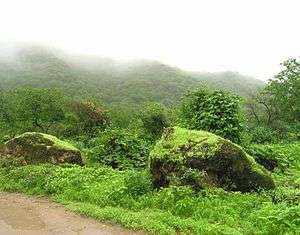Tourism in Oman

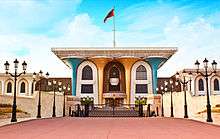
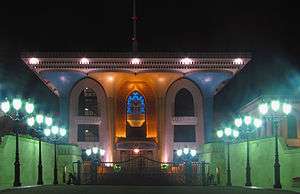
Oman is a country on the Arabian Peninsula. Tourism in Oman has grown considerably recently, and it is expected to be one of the largest industries in the nation.[1]
Oman has one of the most diverse environments in the Middle East with various tourist attractions and is particularly well known for Cultural tourism.[2][3] The capital of Oman was named the Second Best City to visit in the world in 2012 by the travel guide publisher Lonely Planet.[4] Muscat also was chosen as the Capital of Arab Tourism of 2012.[5]
Visa

A single entry visa is issued at the point of entry and is valid for one month. A fine of $4 per day is charged for an overstay beyond the validity of the visa. There are also an express visa, a multiple entry visa and a common visa with Dubai and Qatar, and GCC resident visa.
Statistics
Most tourists coming to Oman in 2013 were from the following countries of nationality (excluding GCC nationals and residents):[6]
| Rank | Country | Number |
|---|---|---|
| 1 | 244,786 | |
| 2 | 133,529 | |
| 3 | 67,893 | |
| 4 | 55,126 | |
| 5 | 53,165 | |
| 6 | 47,830 | |
| 7 | 28,541 | |
| 8 | 26,063 | |
| 9 | 24,897 | |
| 10 | 20,191 | |
Attractions
Beaches
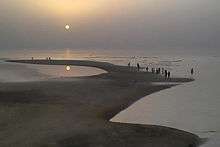

Oman's coast is lined with many soft sand beaches. Activity for beach visitors include sunning, swimming, kitesurfing, diving, snorkeling, boating, surfing, beach combing and shell collecting.
Qurum Beach access is possible from several beachside hotels. This beach is popular with families, walkers, and joggers. The beach is lined with restaurants, snack bars and cafes. At Qantab beach local fishermen will offer fishing excursions and boat rides.
There are an increasing number of resort hotels on the coast west and east of Muscat. These offer dives, snorkeling, speedboat rides and water scooters. The coast beyond Quriyat can be reached by driving southeast on a four-wheel drive. There are a variety of beaches between rocky outcrop, the most prominent being Mokallah (also known as White Beach). This spot is very popular for overnight camping on the shore and snorkelers.
Water sports and diving
Oman offers world class kitesurfing conditions, due to the daily sea breeze effect. Kiteboarding centres can be found at Al Sawadi Beach 70 kilometres north of Muscat and especially on Masirah Island where the monsoon in summer guarantees wind steadily over 20 knots.[7] [8] Muscat city also offers clean safe conditions for learning to kitesurf. Alzaiba Beach is the hot spot for kite surfing and kitesurfing lessons.
With Oman's long coastline and clean unpolluted waters, there is a wealth of underwater flora, and marine life. Sea life is abundant with a variety of hard and soft corals. The waters around Oman have an average visibility of 20–30 meters.
Turtle, dolphin and bird watching
.jpg)
Several species of turtles living for over 100 years swim the length and breadth of the Indian Ocean and return every year to lay their eggs on the beaches of Ras al Hadd, Ras Al Junayz and Masirah island.
Dolphins frequent the seas of Oman on a regular basis and can be seen in close proximity to the coast. Fahal Island is a popular dolphin watching site. Spinner, common and bottlenose dolphins are most common.
Whales visit the shores beaches of the Sultanate at irregular intervals, especially in Ash Sharqiyah and Al Wusta regions, in addition to Dhofar Governorate. The most common types of whales that visit Oman are: Bryde’s whales or tropical whales, blue whales, humpback whales, sperm whales, dwarf sperm whales, Cuvier's beaked whale, pygmy killer whales, killer whales, melon-headed whales and false killer whale.
Oman is becoming increasingly popular with bird watchers. More than 460 different bird species have been recorded in Oman, out of which, 80 species have been classified as resident, while the rest are migrant and seasonal species. Oman offers a unique opportunity to watch birds from Europe, Africa and Asia in one spot during their annual migrations in spring and autumn. These migratory periods coincide with the cooler weather between October and April. Some of the common resident species one expects to see within or around Muscat include: herons (striated and western reef), ospreys, swift terns, laughing doves, Egyptian vultures, and Indian roller. Common migrant and seasonal species include: cattle egret, little stint, greater flamingo, Caspian gull, spotted flycatcher, grey heron, dunlin, Sandwich tern, red and green shanks, ruff and white wagtail.
There is an array of bird watching sites in other parts of the country. Eagles are popular in Musandam. An Arabian oryx sanctuary in Al-Wusta Region provides an opportunity to watch desert species, notably spotted sand grouse, golden eagle and houbara bustard. Masirah Island is the home of thousands of birds especially in the winter such as greater flamingo, seagulls, terns and herons. Dhofar with its diverse terrain and monsoon rains has many birds, particularly African species.
Desert safari
.jpg)
The most renowned Omani desert is Sharqiyah Sands (also called Wahiba Sands) with its dunes rising to nearly 200 meters. Witnessing sun setting is an inspiring event in itself but once the sun has drifted below the dunes a truly spectacular blanket of stars is revealed. Desert adventures in Oman can be by camelback or four-wheel drives. Activities generally include sleeping out in Barsti huts, Omani BBQ under the stars, camel riding and visiting the Bedouins. No desert tour would be complete without jumping on board a sand board. As with snow boarding, sand boarding is becoming a loved sport.
Caving
Oman abounds with many caves of different sizes, topography and ruggedness, some of which can be accessed with a group of amateurs, like Muqal Cave in Wadi Bani Khalid in Ash Sharqiyah region, while others need considerable effort, training, experience and specialized equipment. The most famous cave in Oman is the Al Hoota Cave. It's located at the foot of Jebel Shams of Al Hamra. [9]
The limestone rich sedimentary deposits of Oman's mountains offers some of the most exhilarating cave adventures in the world. There are caves to suit all adventurer's tastes from simple to complex. Oman is home of the world's second largest cave, Majlis Al Jinn (Genies meeting place) with a volume of 4m cubic meters. Be sure to bring long rope as the entrance to the cave is 160 meter free descent. Al Hotah Cave near Al Hamra features an underground cavern and unique underground lake system. Other caves of interest are Moqul Cave in Wadi Bani Khalid and the mostly unexplored Tiq Cave in Dhofar.
Markets
Omani Souqs (Markets) are preferable locations to purchase handicrafts and are always bustling with tourists. Omani markets are characterized by their diversity. Old markets are full of handicrafts like silver, gold, textiles and masterpieces produced by other Omani industries like daggers and coexist with modern shopping malls and other shopping centres that contain everything the visitor is looking for at the best prices.
As for the traditional markets in Oman, the morning hours are the best time for shopping. There are Souqs in every Omani town. The most famous amongst these are the Ruwi and Muttrah Souq. Shoppers can even get their hands on old Arabian muskets at these souqs.
Museums
Trekking and rock climbing
Rock climbing enthusiasts of all levels will find plenty to keep them busy as routes of all grades are available. Rugged mountains, steep cliffs overlooking breathtaking sceneries, rouged paths, deep canyons and towering cliffs present an enigmatic challenge. The rocky towers of Wadi Ghool, scales to a height of 300 meters and the gorgeous façade of Jabal Mishfat has climbs from 120 to 500 meters. Jabal Misht remains the model location due to its rocky façade that extends roughly for 6 km and rises to 850 m. The book "Rock Climbing in Oman" suggest some of the best climbs in Oman.
From intimidating deserts to rugged mountains, serene beaches and tranquil wadis; Oman's landscape offers some exciting opportunities for adventure. Avid trekkers will enjoy the walks through trails over mountains and into canyons, some which have running water all the year round. At the village of Mazara you will find rocky tracks fording the wadi, crystal clear pools of water ideal for a swim. You can hike 13 km into the canyon clear through the other side. Heading out of Mazara on the track to the coast will take you to unusual limestone formations and a track that leads to another scenic area of Wadis Arbien and Suwaih. Both of these Wadis have running water with spots ideal for picnicking and swimming. If you enjoy narrow slot canyons with sheer faces and crystalline pools of water, Wadi Shab, Snake Canyon and Wadi Hajir have just what you are looking for. The book "Adventure Trekking in Oman" covers a number of suitable routes. Oman Tourism Portal will soon make some trekking maps available online.
Forts
Nearly every Omani city and town has its own fort. Most of them were built or had major expansions during Al-Yarubi dynasty rule of Oman in between 1624 and 1744. They represent the fine Omani architecture and prosperity at that time. In times of war and with high and thick walls, their purpose was as a refuge for the people and a last line of defense for the town. Forts were prepared to withstand long siege with water wells, food storing capacity and secret tunnels ending many kilometers away from the walls of the fort. In times of peace they served as a centre of governance, a place for education and a social interaction point.
The list is long but here are some of the well-known names: Al-Jalali Fort, Al-Mirani Fort, Nakhal Fort, Rustaq Fort, Sohar Fort, Nizwa Fort, Bahla Fort, Qurayat Fort, Khasab Fort, Al-Hellah Fort, Al-Khandaq Fort, As-Suwaiq Fort, Barka Fort, Bait An-Nuaman, Al-Hazm Fort, Ibri Fort, Bait Ar-Radaidah, Jibrin Fort, Al-Muntarib Fort, As-Sunaisilah Fort, Bilad Sur Fort, Ras al-Hadd Fort, Mirbat Fort, Sadah Fort and Taqa Fort.
World Heritage Sites
The UNESCO through its International Heritage Preserve Programme Administration, aim to categorise all significant heritage sites worldwide.
Bahla Fort
Bahla Fort, Bahla Fort lies in Bahla State in Dakiliya region. Since 1987, its name has been included in the World Heritage Sites List. Bahla Fort includes: Bahla Oasis with its traditional souks, old alleys, ancient mosques and its wall that extends over a distance of approximately 13 kilometres and whose construction dates back to the pre-Islamic era. Originally, Bahla Fort was built in the third millennium BC. The length of its South façade is about 112 metres, while its eastern façade is about 114 metres. It is evident that Bahla Wall that extends over a distance of 12 kilometres, with its terraces, apertures for opening fire and guards houses had been designed for defence purposes.
Ancient settlements and tombs
The third-millennium BC settlement and tombs in Bat, the Al-Khatm and Al-Ain locations in Adh-Dhahira region, Bat Tombs historical sites are located in Bat, Al Khutum and Al Ayn in Ad Dhahirah region in Ibri Governorate. They are considered one of the archaeological and historical sites that date back to the third century BC and are located to the east of Ibri. In 1988, Bat Tombs was the second site to be included in the World Heritage list in Oman. In the southern part, the site is a collection of graves built on the lines of those found in Um AnNar, while in the northern part, the graves look like beehives and date back to the third millennium BC. The architecture is similar to the tombs built in the Hafit period. Another cemetery containing 100 tombs built of stone was also discovered, where the evolution from the beehive style to cemeteries built during Um AnNar period is apparent. While the beehive cemetery contained between two and five tombs, Um AnNar cemeteries were mass graves. A similar cemetery of this style was discovered containing 30 burial chambers. The historic significance of the Bat site is that it is located at the crossroads of an ancient trade route. Caravans loaded with goods heading to other nearby destinations passed through Bat. Included with the Bat settlement in the World Heritage List are two other sites: Al Khutum “Al Wahrah” and Wadi Al Ayn Tombs.
Frankincense Route
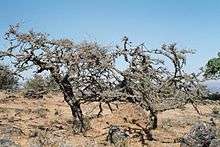
The luban (frankincense) route in Dhofar. The route comprises the ancient cities of Al-Blaid and Shasr, Khuwr Rori, and Wadi Dooka. These locations collectively contributed to the flourishing of frankincense trade for many centuries. The frankincense trees in Wadi Dukah, the Al Shisur Oases and the ports of Khawr Ruri and Khawr Al Baleed have contributed to the prosperity of the frankincense trade in the region for several centuries. It was one of the most active trades in the Middle Ages and earlier.
The Frankincense Route contains a number of sites where the process of manufacturing and exporting of frankincense took place. Some of the frankincense trails incorporated in the World Heritage List in 2000 are:
- Frankincense Land Museum: The Land of Frankincense Museum is considered one of the most prominent historical museums in Oman.[10]
- Al Balid City: dates back to before 2000 BC. Some archaeological research confirms that the city's prosperity dates back to the Iron Age.[11]
- Khawr Al Baleed: This lagoon takes its name from the ancient city which lies on the banks of this lagoon. The lagoon flanks the city on the east and north.[12]
- Khawr Ruri (Samhram City): Khawr Ruri is the largest reserve in the Governorate of Dhofar. It is considered the most attractive to tourists as it contains Khawr Ruri port.[13]
- Shisur / Awbar: The ruins of Awbar lie in Dhofar Governorate. This city remained lost for centuries and was considered one of the mysterious archaeological secrets.[14]
- Wadi Dukah: Wadi Dukah lies in Najd region on the northern slopes of Dhofar Governorate, located approximately 25 kilometres north of the city of Salalah. Wadi Dukah is a model valley of the areas where the frankincense trees grow.
Falajs
.jpg)
Five falajs. In July 2006, the World Heritage Committee endorsed the inclusion of the five Omani falajs in the World Heritage List to express the international standing of this unique water system that represents a cultural legacy created by the Omanis over 2,000 years ago, being the oldest irrigation structure in the region. It is still the major source of irrigation in the Sultanate and a water source that can be relied on in most Omani cities and villages. It is rare to find anything like these falajs elsewhere in the world. They are:
- Falaj Daris is one of the largest falaj in Oman and lies in Wilayat Nizwa in A'Dakhiliyah Region. It is a Dawoodi Falaj. It consists of two branches: The “Big Branch” running for a length of 1,700 metres, and the "Small Branch” with a length of 1,900 metres. Falaj Daris stems from Wadi Al Abyad (White Valley). A lot of this State’s residents depend on Falaj Daris to water their crops that extend from Shariat Al Falaj in Daris to the market area.
- Falaj Al Khatmayn: Falaj Al Khatmayn lies in Birkat Al Mawz village in Wilayat Nizwa in A'Dakhiliyah Region. It is a Dawoodi Falaj and is fed by Wadi Al Muaydin that flows heavily during rainfall. Its total length is about 2,450 metres. It is a branch of the Dawoodi falaj that flows plentifully during heavy rainfall. Its overall length is about 2,450 metres. Falaj Al Khatmayn is characterized by its acute precision in the distribution of falaj water and continuous flow throughout the year. What distinguishes this Falaj is that its course runs through Bayt Ar Rudaydah, one of the famous castles in Oman.
- Falaj Al Malaki: Falaj Al Malaki is located in Wilayat Izki in A'Dakhiliyah Region. and is one of the oldest falaj in the Sultanate. Falaj Al Malaki is considered one of the largest Dawoodi Falaj as it has 17 branches that feed the falaj.
- Falaj Al Muyassar: Falaj Al Muyassar is one of the most important falajs in Wilayat Ar Rustaq in Al Batinah Region. It is characterized by its deep waterway and the large number of its branches
- Falaj Al Jaylah: Falaj Al Jaylah is an Ayni Falaj. It lies in Al Jaylah town in Sur in A'Sharqiyah Region(Eastern Region) and is fed by Wadi AlShab. Feeding from Wadi Shab, this falaj is the town’s main water source. The length of its open channels that starts from the fountainhead and ends and at the water basin is 161 metres. Falaj Al Jaylah water is used for irrigation. This falaj has been included in the World Heritage List.
Horse and camel racing
Between the months of September and June equestrian races organised by Oman Equestrian Federation are held in various towns. The Royal Stables in Seeb is a good spot to observe equestrian events staged for public and private gatherings. Al Kamil/Al Wafi region of the country has the best breeders and trainers. Horse Races are often opened by the art of Al-Taghrood (chanting) enticing riders and horses. This act signifies both courage and chivalry and lauds the virtues of the horses.
Omani people take pride and full care in raising their camels implementing strict methods of taming and nourishment. Camels bred for racing undergo intensive training in order to compete at national and international levels. Camels are given names reflecting their respective abilities and endurance. A good racing camel can fetch a price of R.O. 30,000 (US $ 77,400). Jockeys are drafted for their size (or lack thereof) and some make their professional debuts around five years old. Camels participate in long distance races held on specially built race tracks. Crowd enthusiasm is high on these occasions. The races are normally held on public holidays and during National Day celebrations. As with Horse Races, camel races are arranged by OEF. Some Regions organize their own local races.
Events
Muscat Festival
Muscat Festival[15] is held annually between January and February. With a large Heritage Village on-site, visitors can experience the traditional Omani lifestyle, through various artistic and cultural activities held daily. As the Festival comes to town, so too does the Circus as well as a wide range of musical stars, both local and international. The Festival also hosts a vast array of international exhibitors. Furthermore, local and foreign troupes engage audience with their folklore dances and amusement parks charm the children.
Salalah Festival
Salalah Festival takes place in the months of July and August. As the temperature soars in the North of Oman and the rest of the Gulf states, the Khareef season sweeps over the southern part of Oman dropping temperature to and below 23°C (73 °F). Salalah in Dhofar gears up to take over the role as the Oman top tourist destination. The monsoon rains nourish the region of Dhofar and fog hangs over the land, resulting in some of the most stunning natural scenery. The festival rolls into town with plenty of family fun in the form of cultural, traditional and modern artistic shows. This combination of idyllic weather, the green land and man-made celebrations make visitors experience something truly unique.
Cultural theatre program

Every year, during the period from December to the end of March, the Ministry of Tourism organises a number of cultural evenings at the ancient Al Flayj Castle Theatre, hosting popular groups from around the world.
The Ministry also organises similar evenings in Al Morooj Theatre, Salalah, Dhofar Governorate.
Dubai–Muscat offshore sailing race
Dubai–Muscat Regatta takes place every January. Boats set sail from Dubai passing through the Straits of Hormuz before heading down towards Muscat, ending their quest at the Bandar Al-Rawdah Marina.
Sinbad Classic
An international deep sea fishing contest, the Sinbad Classic is one of the IGFA World Championships qualifying rounds taking place each April with participants coming from all across the globe to fish in the event. The 2008 event runs from 27–29 March and in contrast to previous years is taking a firm stance on sustainable development within the sports industry. For more information on the Sinbad Classic go to www.sinbadclassic.com
Oman Adventures
This event which is held annually in November features teams of two individuals each; one runs while the other cycles. Held over a five-day period, with each day constituting a one-day phase, the race starts in the early hours of the morning and concludes in the evening, with a one-off special night phase. The challengers face a systematically organised course parts of which necessitate the carrying of the bicycle on the shoulders. Each team is entirely responsible for the preparation and coordination of their own food and water supply, in addition to any spare parts needed for their bicycles.
Oman International Rally
Oman International Rally; held annually in March, is one of the few rallies that constitute the Middle East Rally Championship.
Oman Desert Express
An annual event held in February, the Oman Desert Express Rally is of great interest to adventurers seeking the ultimate challenge of nature.
Bidiyah Challenge
Held every February in the town of Bidiya in Sharqiyah Region. Recently introduced to the Gulf Region’s sporting calendar, the aim of the race is to scale sand dunes in the least possible time.
Oman World Fireworks Championship 2010
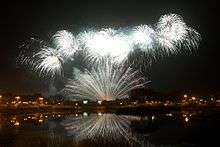
The Oman World Fireworks Championship 2010[16] was one of the largest and most spectacular fireworks competition in the world. It was part of the 40th National Day Celebrations of the Sultanate of Oman, and it considered to be the largest fireworks event ever held in the Middle East. Coming from Europe, Asia, Australasia and the Americas, six of the world's very best pyrotechnic production companies had put their skills, artistry and technological know-how to the test, as they battle it out for the coveted Champion's Trophy. The Winner's Trophy was awarded to Lacroix-Ruggieri of France, with second place tied between Panzera of Italy and Vulcan of China.
Tour of Oman
This cross-country cycling event is now held annually. Its stated goals are to promote cycling as a sport in Oman; to put Oman on the world stage as an attractive tourist destination; and stimulate trade and economic activity within the country.[17]
Hotels
Almost all international hotel chains have opened up outlets in Oman. Grand Hyatt, Crowne Plaza, Intercontinental, Shangri-La, Chedi, Ramada, Sheraton and Golden Tulip Hospitality Group are just a few. Apart from this the domestic hotel chains have also made a name for themselves like Al Nahda Resort, etc.
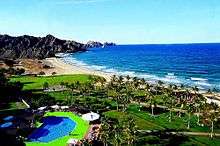 Ritz-Carlton, Al-Bustan Palace Hotel
Ritz-Carlton, Al-Bustan Palace Hotel.jpg) Grand Hyatt hotel in Oman
Grand Hyatt hotel in Oman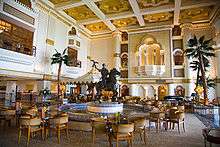 Inside of the Grand Hyatt in Oman
Inside of the Grand Hyatt in Oman- Desert Night Resort at Wahiba Sands
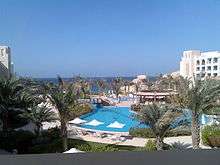
Shopping
Oman’s mix of traditional and cosmopolitan shopping venues offers a great insight into the life and culture of Omani people. The traditional Arabic market place is called the Souq and it sells household items as well as traditional handcrafts. Beside its economic purpose, the Souq has long been a focal point of social interaction. A visit to Muttrah, Nizwa and Salalah Souqs is a must. Tourists could buy carved hand-made distinctive Omani Khanjars (daggers), rose-water sprinklers, fragrant frankincense, incense burners, garments, rugs and saddles. Women jewellery ranges from small silver boxes, to earrings and rings, bracelets, anklets and necklaces. In some Souqs like Nizwa and Sinaw livestock are auctioned and bartered.
Gallery
 Al Alam Palace, Muscat
Al Alam Palace, Muscat Al Khuwair - The two Khanjar's (left of image) mark the entrance to the Ministries Street which houses all the Ministries of Oman
Al Khuwair - The two Khanjar's (left of image) mark the entrance to the Ministries Street which houses all the Ministries of Oman Muscat Harbor - A traditional Omani Dhow lays anchored in the Muscat Harbor (World's largest natural harbor)
Muscat Harbor - A traditional Omani Dhow lays anchored in the Muscat Harbor (World's largest natural harbor) Muscat Port - The Sultan's Yacht can be seen anchored at the Port.
Muscat Port - The Sultan's Yacht can be seen anchored at the Port.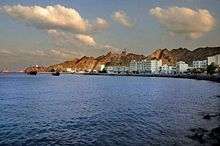 Mutrah Corniche
Mutrah Corniche Mutrah Corniche
Mutrah Corniche The Muscat Fort (Built by the Portuguese in the 16th century) overlooks the Muscat harbor, Mutrah and the Al Alam Palace
The Muscat Fort (Built by the Portuguese in the 16th century) overlooks the Muscat harbor, Mutrah and the Al Alam Palace- Riyam Park - as seen in Amazing Race 9 - is very near to the Muscat Harbor
- The Mutrah Corniche was renovated to undo the destruction done by Cyclone Gonu
 Muscat Clock Tower, MBD, Ruwi - It’s the oldest Monument in Modern Oman and showcases the Sultanate’s commitment to modernization
Muscat Clock Tower, MBD, Ruwi - It’s the oldest Monument in Modern Oman and showcases the Sultanate’s commitment to modernization Beaches of Oman along with its cliffs attracts tourists from all over the world
Beaches of Oman along with its cliffs attracts tourists from all over the world- Qantab Beach
- Qurum Beach - Crowne Plaza Muscat can be seen in the distance (on the cliff-top)
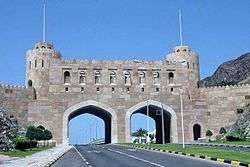 Muscat Municipality works continuously to beautify the city. Such gates dot roads around Muscat and showcase the traditional roots of the Sultanate
Muscat Municipality works continuously to beautify the city. Such gates dot roads around Muscat and showcase the traditional roots of the Sultanate Muscat Boat Club
Muscat Boat Club Ruwi - The Commercial hub of Muscat includes a massive marketplace - The Ruwi High Street
Ruwi - The Commercial hub of Muscat includes a massive marketplace - The Ruwi High Street.jpg) Wadi Shab and Wadi Tiwi
Wadi Shab and Wadi Tiwi
See also
- Visa policy of Oman
- Al Alam Palace
- Cities in Oman
- Economy of Oman
- Geography of Oman
- Project Green Oman
- Provinces of Oman
- Muscat
- Muttrah
- Nizwa
- Royal Opera House Muscat
- Salalah
- Shangri-La's Barr Al Jissah Resort & Spa
- Sohar
- Sur
- The World Fireworks Championship
References
- ↑ "Travel & Leisure Market Research Reports and Industry Analysis". Marketresearch.com. Retrieved 2013-06-09.
- ↑ Kharusi, N. S. & Salman, A. (2011) The English Transliteration of Place Names in Oman. Journal of Academic and Applied Studies Vol. 1(3) September 2011, pp. 1-27 Available online at www.academians.org
- ↑ Babu Thomas Web Developer- designer. "Culture in Oman, Tourism". Omanet.om. Retrieved 2013-06-09.
- ↑ Richard I'Anson. "Lonely Planet's Best in Travel: top 10 cities for 2012 - travel tips and articles". Lonely Planet. Retrieved 2013-06-09.
- ↑ "Home Page - Gulf in the Media". Retrieved 23 December 2015.
- ↑ Number of Tourists to Oman
- ↑ http://www.theguardian.com/travel/2010/sep/04/masirah-island-oman-middle-east The Guardian, "Oman's desert island", retrieved 5 January 2014
- ↑ http://www.surfertoday.com/travel/8793-riding-the-desert-winds-of-the-masirah-island Surfer Today, "Riding the desert winds of the Masirah Island", retrieved 5 January 2014
- ↑ "Home". Alhootacave.com. Retrieved 2013-06-09.
- ↑ "Travel to Oman, Visit Muscat through Oman Travel Guide for Sultanate of Oman Adventure - Ministry of Tourism, Sultanate of Oman". Retrieved 23 December 2015.
- ↑ "Travel to Oman, Visit Muscat through Oman Travel Guide for Sultanate of Oman Adventure - Ministry of Tourism, Sultanate of Oman". Retrieved 23 December 2015.
- ↑ "Travel to Oman, Visit Muscat through Oman Travel Guide for Sultanate of Oman Adventure - Ministry of Tourism, Sultanate of Oman". Retrieved 23 December 2015.
- ↑ "Travel to Oman, Visit Muscat through Oman Travel Guide for Sultanate of Oman Adventure - Ministry of Tourism, Sultanate of Oman". Retrieved 23 December 2015.
- ↑ "Travel to Oman, Visit Muscat through Oman Travel Guide for Sultanate of Oman Adventure - Ministry of Tourism, Sultanate of Oman". Retrieved 23 December 2015.
- ↑ "muscat-festival.com". Retrieved 23 December 2015.
- ↑ "The World Fireworks Championship - the world's leading fireworks competition". Retrieved 23 December 2015.
- ↑ "Tour of Oman". Tourofoman.om. 2013-02-16. Retrieved 2013-06-09.
Articles
- Vogue magazine chooses Oman as 2008 top destination
- Oman shines as hottest new destination
- British media shower praises on Oman’s immaculate beauty
- Discover Oman: One Land, One Breathtaking Journey Authentic Arabia
- The beginner’s guide to Oman
- Muscat to Host World Fireworks Championship in December
External links
General
- Oman Tourism Portal
- Ministry of Information - Tourism Section
- Bradt Guide - Oman
- Lonely Planet - Oman
- Muscat International Airport
- Muscat Travel Portal
- Oman Air
- Oman Tourism and Hospitality Academy
- Geological Society of Oman
- Oman Center for Traditional Music
- Oman World Fireworks Championship 2010
- Kiteboarding Oman - First certified kiteboarding centre in the Gulf region
.jpg)
